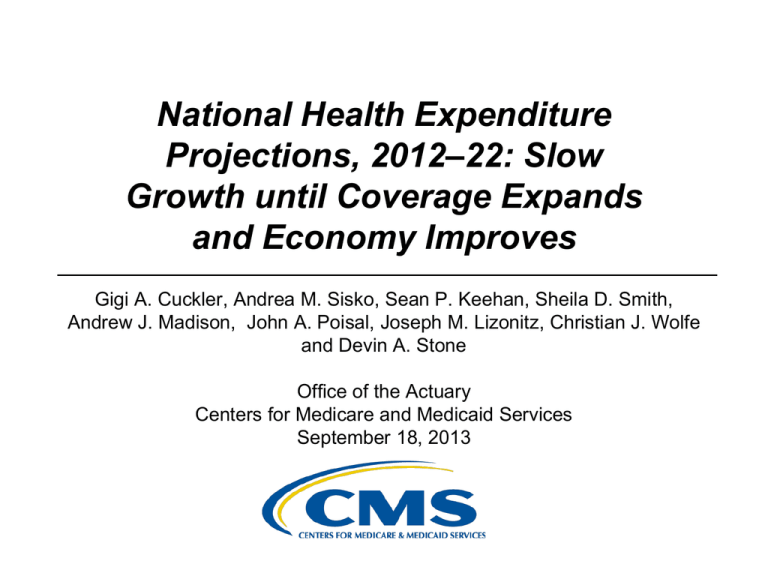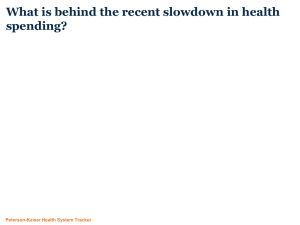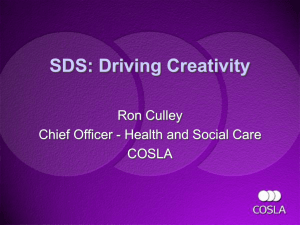Slides - Health Affairs
advertisement

National Health Expenditure Projections, 2012–22: Slow Growth until Coverage Expands and Economy Improves Gigi A. Cuckler, Andrea M. Sisko, Sean P. Keehan, Sheila D. Smith, Andrew J. Madison, John A. Poisal, Joseph M. Lizonitz, Christian J. Wolfe and Devin A. Stone Office of the Actuary Centers for Medicare and Medicaid Services September 18, 2013 NHE Projections Overview • Health spending growth is projected to remain slow, near 4 percent through 2013 • In 2014, national health spending is projected to increase 6.1 percent – Expansions of Medicaid and private health insurance coverage under the Affordable Care Act are projected to increase the demand for health care, particularly for prescription drugs and physician and clinical services • By 2022, the number of uninsured Americans is projected to be reduced by 30 million as a result of the Affordable Care Act • For 2012-22, health spending is projected to grow at an average rate of 5.8 percent per year, leading to a projected health share of GDP of 19.9 percent by 2022 • Although projected growth is faster than in the recent past, it is still slower than the growth experienced over the longer term NHE Projections Methods • Health spending projections for 2012-22, without the effects of the Affordable Care Act (ACA), were developed using actuarial and econometric modeling techniques, by type of service/good, payer, and sponsor • The impacts of the ACA were estimated using the Office of the Actuary Health Reform Model (OHRM) and applied to the baseline • New in these projections: – Current Law Alternative to Sustainable Growth Rate (SGR) – Projections incorporate June 2012 Supreme Court ruling as applicable to the Medicaid expansion – Projections account for one-year delay in employer mandate Growth in National Health Expenditures (NHE), 1990-2022 12.0 NHE absent ACA (blue dash) Annual Growth Rate (%) 10.0 8.0 6.0 4.0 2.0 NHE current law with alternative to SGR (blue solid line) Nominal GDP (red dotted) 0.0 -2.0 1990 1994 1998 2002 2006 2010 2014 2018 2022 Source: Cuckler G et al., “National Health Expenditure Projections, 2012–22: Slow Growth until Coverage Expands and Economy Improves” Health Affairs 32, no. 10 (2013) (to be published online 18 September 2013). NHE Share of Gross Domestic Product (GDP), 1990-2022 2012: 2022: 17.9% 19.9% 20.0 Share of GDP (%) 18.0 16.0 14.0 12.0 10.0 1990 1994 1998 2002 2006 2010 2014 2018 2022 Source: Cuckler G et al., “National Health Expenditure Projections, 2012–22: Slow Growth until Coverage Expands and Economy Improves” Health Affairs 32, no. 10 (2013) (to be published online 18 September 2013). Impact of the Affordable Care Act • ACA Impacts for 2012 to 2022 – Projected to reduce the number of uninsured people by thirty million – Add approximately 0.1 percentage point to average annual health spending growth over the full projection period – Increase cumulative health spending by $621 billion • Major Coverage Expansion Impacts (2014 to 2015) – In 2014, NHE is projected to grow 6.1 percent (1.6 percentage-points faster than in the absence of the ACA), reflecting expanded insurance coverage primarily through Medicaid and Health Insurance Marketplaces – In 2015, growth in national health spending is projected to remain near 6 percent as the major effects of the coverage expansions continue • After initial coverage expansions (2016 to 2022) – The most significant one-time effects of the coverage expansions are expected to subside – However, Medicare spending growth constrained under reform with limits in growth for certain Medicare provider payment updates and lower payments to Medicare private plans NHE Distribution and Average Annual Growth by Type of Service, 2012-2022 Distribution of Spending Annual Growth in Spending Hospital 4.5% 4.7% 5.6% 6.4% Physician 4.3% 7.1% 5.4% 6.2% Hospital Care 32% 32% Physician & Clinical Services 20% 20% 9% 9% 23% 23% 16% 16% 2012 2022 Prescription Drugs All Other Non-PHC -0.1% 5.2% 6.9% 6.4% Prescription Drugs 2012-13 2014 2015 2016-22 NOTE: Sum of pieces may not equal 100% due to rounding. All Other PHC includes spending for the categories of: Dental, Other Professional, Nursing Home, Home Health, Durables, Other Nondurables, and Other Personal Health Care. The Non-PHC categories are: Government Administration, Net Cost of Private Health Insurance, Government Public Health, Research, Structures, and Equipment. SOURCE: CMS, Office of the Actuary, National Health Statistics Group. 7 NHE Distribution and Average Annual Growth by Payer, 2012-2022 Distribution of Spending 11% 33% 21% 9% 33% 22% 15% 17% 20% 19% 2012 2022 Annual Growth in Spending 3.4% Out Of Pocket Private Health Insurance Out Of Pocket -1.5% 3.0% 4.6% 3.6% 7.7% 6.2% 5.8% 4.4% 5.1% 5.4% 7.7% 3.5% 12.2% 8.3% 6.8% Private Health Insurance Medicare Medicaid All Other NOTE: Sum of pieces may not equal 100% due to rounding. SOURCE: CMS, Office of the Actuary, National Health Statistics Group. Medicare Medicaid 2012-13 2014 2015 2016-22 8 NHE Distribution and Average Annual Growth by Type of Sponsor, 2012-2022 Distribution of Spending 18% 26% 7% 28% 18% State and local government 31% Federal government 7% 25% 21% 19% 2012 2022 Other Private Revenues Annual Growth in Spending 6.0% 5.6% 5.8% 6.2% State and Local Government 2.3% Federal Government 13.8% 6.8% 7.3% 3.9% 0.7% 5.1% 5.9% Households Households 3.5% 4.5% 5.8% 5.4% Business Business NOTE: Sum of pieces may not equal 100% due to rounding. SOURCE: CMS, Office of the Actuary, National Health Statistics Group. 2012-13 2014 2015 2016-22 9 A Detailed Review of Key Findings by Time Period Key Findings for 2012-13 Annual Growth in NHE, in historical context • National health spending estimated to have reached $2.8 trillion in 2012 • NHE growth projected to remain below 4 percent through 2013 due to: NHE 6.9% 3.9% 3.9% 3.8% – sluggish economic recovery – continued increases in cost-sharing requirements for the privately insured – low growth for Medicare and Medicaid 2000-2009 2010-2011 2012 2013 SOURCE: CMS, Office of the Actuary, National Health Statistics Group. 2012 2013 2014 2015 2016 2022 Key Findings for 2012-13 Average Annual Growth for Medicare & Medicaid Spending in 2012-13, in historical context • • Medicare: slowdown in growth across most services in 2012; sequestration further slows projected growth in 2013 Medicaid: slower estimated growth in 2012 due to expiration of enhanced FMAP rates in 2011, state cost containment efforts; faster projected growth in 2013 due to higher spending per enrollee, supplemental payments to providers Medicare Medicaid 9.3% 7.2% 5.2% 4.6% 4.8% 4.2% 4.2% 2.2% 2000-2009 2010-2011 2012 2013 SOURCE: CMS, Office of the Actuary, National Health Statistics Group. 2012 2013 2014 2015 2016 2022 Key Findings for 2012-13 Average Annual Growth for Private Health Insurance Spending in 2012-13, in historical context Continued slow growth is largely due to ongoing increases in plan cost-sharing, the decline in prescription drug spending, and continued restraint in the use of physician office visits Private Health Insurance 6.9% 3.6% 2000-2009 3.8% 2010-2011 3.4% 2012 2013 SOURCE: CMS, Office of the Actuary, National Health Statistics Group. 2012 2013 2014 2015 2016 2022 Key Findings for 2012-13 Continued Slow Estimated Growth Across Major Health Services, in historical context • • 2012 would be third consecutive year of growth under 5 percent for hospital; fourth consecutive year for physician & clinical services Both hospital and physician growth impacted by projected slower economic and price growth, sequestration in 2013 Hospital Physician & Clinical Services 7.2% 6.3% 4.9% 4.6% 4.6% 4.1% 2000-2009 3.7% 2010-2011 2012 3.9% 2013 SOURCE: CMS, Office of the Actuary, National Health Statistics Group. 2012 2013 2014 2015 2016 2022 Key Findings for 2012-13 Continued Slow Estimated Growth Across Major Health Services, in historical context • • Estimated decline in 2012 due to increased adoption of generic drugs as a number of popular brand-name drugs lost patent protection, increases in costsharing requirements, and lower spending on new medicines 2013 growth reflects diminished effect of patent expirations, faster growth in specialty drugs and in dispensed prescriptions Prescription Drugs 8.6% 1.6% 0.6% -0.8% 2000-2009 2010-2011 2012 2013 SOURCE: CMS, Office of the Actuary, National Health Statistics Group. 2012 2013 2014 2015 2016 2022 Key Findings for 2014 Projected growth in 2014 by Payer Annual growth reflects differential impacts of coverage expansion 14.0% 12.2% 12.0% 10.0% 7.7% 8.0% 6.0% 6.1% 5.3% 4.5% 3.3% 4.0% 3.0% 2.0% -1.5% 0.0% -2.0% NHE Private Health Insurance Medicaid Out-of-Pocket -4.0% Absent ACA Current Law with Alternative to SGR SOURCE: CMS, Office of the Actuary, National Health Statistics Group. 2012 2013 2014 2015 2016 2022 Key Findings for 2014 Projected Impact of Coverage Expansion on 2014 Growth in Services • • The newly insured are anticipated to be younger and healthier, and require less acute care compared to people who currently have coverage Consequently, the newly insured are expected to devote a higher share of their medical spending to physician services and prescriptions drugs relative to currently insured individuals 8.0% 7.0% 6.0% 5.0% 4.0% 3.0% 2.0% 1.0% 0.0% 7.1% 5.2% 5.0% 4.6% 4.7% 2.3% Prescription Drugs Absent ACA Physician & Clinical Services Hospital Current Law with Alternative to SGR SOURCE: CMS, Office of the Actuary, National Health Statistics Group. 2012 2013 2014 2015 2016 2022 Key Findings for 2015 Projected growth in 2015 by Payer, in context Annual growth reflects faster economic growth, effect of continued coverage expansion 14.0% 12.0% 10.0% 8.0% 6.0% 4.0% 2.0% 0.0% -2.0% -4.0% 12.2% 6.1% 5.8% 3.8% 8.3% 7.7% 6.2% 4.8% 3.4% 2.7% 3.0% -1.5% NHE Private Health Insurance 2013 2014 Medicaid Out-of-Pocket 2015 SOURCE: CMS, Office of the Actuary, National Health Statistics Group. 2012 2013 2014 2015 2016 2022 Key Findings for 2015 Projected Growth by Major Service, in context Faster economic growth, combined with the continued effect of the coverage expansions are expected to result in elevated growth among the major services in 2015 8.0% 7.0% 6.0% 5.0% 4.0% 3.0% 2.0% 1.0% 0.0% 7.1% 6.9% 5.6% 5.4% 5.2% 4.1% 3.9% 4.7% 0.6% Prescription Drugs Physician & Clinical Services 2013 2014 Hospital 2015 SOURCE: CMS, Office of the Actuary, National Health Statistics Group. 2012 2013 2014 2015 2016 2022 Key Findings for 2016-2022 Average Annual Growth For Major Payers, 2016-22 • • • Medicare growth influenced by faster growth in enrollment and per enrollee spending due to population aging, expiration of sequestration in 2022; slower growth related to ACA mandated payment adjustments Medicaid is projected to grow faster under continuing coverage expansion (through 2016) and faster enrollment of aged and disabled Private health insurance growth influenced by faster economic growth 7.7% 8.0% 6.8% 6.3% 6.0% 5.8% 4.0% 2.0% 0.0% NHE Medicare Medicaid Private Health Insurance SOURCE: CMS, Office of the Actuary, National Health Statistics Group. 2012 2013 2014 2015 2016 2022 Conclusion • Health spending growth is projected to remain slow, near 4 percent through 2013 • In 2014, national health spending is projected to increase 6.1 percent – Expansions of Medicaid and private health insurance coverage under the Affordable Care Act are projected to increase the demand for health care, particularly for prescription drugs and physician and clinical services • By 2022, the number of uninsured Americans is projected to be reduced by 30 million as a result of the Affordable Care Act • For 2012-22, health spending is projected to grow at an average rate of 5.8 percent per year, leading to a projected health share of GDP of 19.9 percent by 2022 • Although projected growth is faster than in the recent past, it is still slower than the growth experienced over the longer term







